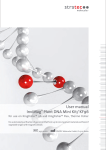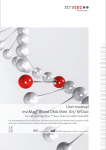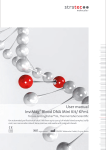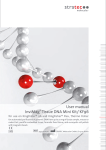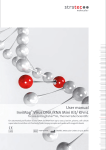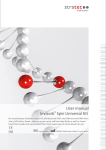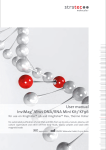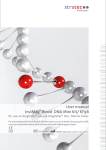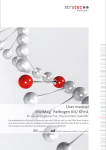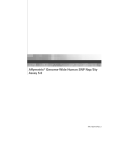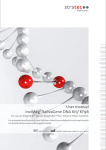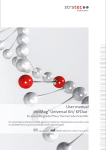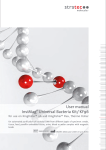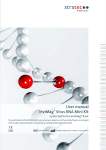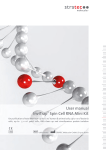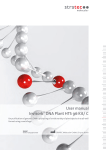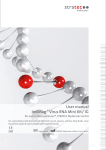Download InviMag Universal Kit/ KF96 User manual
Transcript
User manual InviMag® Universal Kit/ KF96 for use on KingFisher® 96 and KingFisher® Flex, Thermo Fisher Scientific for automated purification of DNA (genomic, bacterial, mitochondrial and viral) as well as viral RNA from up to 200 µl of clinical samples with magnetic beads REF 7450300X0 STRATEC Molecular GmbH, D-13125 Berlin Instruction for InviMag® Universal Kit/ KF96 The InviMag® Universal Kit/ KF96 combines the advantages of the innovative InviMag® technology with easy handling of magnetic particles in combination with either the KF96 or KFflex96 robotic platform from Thermo Fisher Scientific for a very efficient and reliable isolation of nucleic acids with a high purity. The kit is the ideal tool for semi-automated isolation and purification of total (genomic, bacterial) DNA and/or viral DNA/RNA from up to 200 µl sample volume. The interplay of the nucleic acid extraction and purification chemistry provided by the InviMag® Universal Kit/ KF96 was intensely tested and validated. The nucleic acid binding particles are characterized by a high surface area, uniform size distribution, good suspension stability and therefore are highly suitable for high-throughput processing. Due to the high purity of the derived eluates, the isolated nucleic acids are ready-to-use in a broad spectrum of downstream applications or can alternatively be stored at -20°C/-80°C for subsequent use. For research use only! Trademarks: InviMag®, Invisorb®. Registered marks, trademarks, etc. used in this document, even when not specifically marked as such, are not to be considered unprotected by law. The Invisorb® technology is covered by patents and patent applications: US 6,110363, US 6,043,354, US 6,037,465, EP 0880535, WO 9728171, WO 9534569, EP 0765335, DE 19506887, DE 10041825.2, WO 0034463. InviMag® and Invisorb® are registered trademarks of STRATEC Biomedical AG. The PCR process is covered by US Patents 4,683,195, and 4,683,202 and foreign equivalents owned by Hoffmann-La Roche AG. © 2015 STRATEC Molecular, all rights reserved. 1 InviMag® Universal Kit/ KF96 0515 Table of content Kit contents of InviMag® Universal Kit/ KF96 Kit contents of InviMag® Universal Kit/ KF96 w/o plastic Symbols Storage Quality Control and product warranty Intended use Product use limitation Safety information Product characteristics of the InviMag® Universal Kit/ KF96 Sampling and storage of starting material Principle and procedure Procedure Yield and quality of genomic DNA derived from blood Yield and quality of viral nucleic acids Protocol validation Important notes Preparing reagents and buffers Reagents and equipment to be supplied by user Important indications Scheme of the InviMag® Universal Kit/ KF96 Lysis procedures Protocol 1: Simultaneous isolation of nucleic acids (viral DNA/RNA) from cell-free body fluids or blood (genomic DNA) Protocol 2: Simultaneous isolation of nucleic acids (DNA/RNA) from swab material Protocol 3: Simultaneous isolation of nucleic acids (DNA and RNA) from tissue biopsies Protocol 4: Isolation of DNA from bacteria pellets (up to 1 x 109 bacterial cells) Protocol 5: Simultaneous isolation of total nucleic acids from sputum Protocol 6: Simultaneous isolation of total nucleic acids (DNA and RNA) from tracheal secretes or BAL Protocol 7: Simultaneous isolation of viral nucleic acids from stool samples Protocol 8: Isolation of bacterial DNA from stool samples Starting a Run For self-programming of the KF96 and KFflex96 instrument Troubleshooting Appendix General notes on handling DNA General notes on handling RNA Ordering information 2 3 4 5 5 5 6 6 7 8 9 10 10 10 11 11 14 14 15 15 16 17 17 18 19 19 20 20 22 22 23 25 28 30 31 32 33 InviMag® Universal Kit/ KF96 0515 Kit contents of InviMag® Universal Kit/ KF96 Store the MAP Solution B and Carrier RNA at 2-8°C! Store dissolved Proteinase K / Carrier RNA in aliquots at -20°C! Store all other kit components at room temperature (RT*)! Component 1 x 96 preparations 5 x 96 preparations 7450300100 15 ml 7450300200 15 ml 150 mg 150 mg 30 ml 120 ml 2 x 1.2 ml working solution 15 ml working solution 3 x 2 ml 2 x 15 ml 2 x 1.1 ml working solution 10.5 ml working solution 2 x 1.1 ml 10.5 ml Catalogue No. Lysozyme Buffer Lysozyme Lysis Buffer HLT Carrier RNA RNAse Free Water Proteinase K SNAP Solution Binding Solution empty bottle empty bottle (final volume 30 ml) (final volume 120 ml) Wash Buffer HLT 90 ml (final volume 150 ml) 360 ml (final volume 600 ml) Wash Buffer II 45 ml (final volume 150 ml) 180 ml (final volume 600 ml) Wash Buffer M 30 ml (final volume 120 ml) 150 ml (final volume 600 ml) 15 ml 60 ml KF96 Tip Comb for DW magnets 1 5 2.0 ml Deep Well Plate 4 5x4 200 µl Elution Plate 2 5x2 Sealing Foils 2 10 2 x 50 pcs. 10 x 50 pcs. 1 1 Add 60 ml of abs. 99.7% Isopropanol to the bottle Wash Buffer HLT, mix thoroughly and keep the bottle firmly closed! Add 240 ml of abs. 99.7% Isopropanol to the bottle Wash Buffer HLT, mix thoroughly and keep the bottle firmly closed! Add the provided amount of Lysozyme to the bottle with the Lysozyme Buffer and mix it thoroughly Add the provided amount of Lysozyme to the bottle with the Lysozyme Buffer and mix it thoroughly (fill with 99.7% Isopropanol) Elution Buffer M 1.5 ml Receiver Tubes Manual Initial steps Add 90 ml of 96-100% ethanol to the bottle Wash Buffer M, mix thoroughly and keep the bottle firmly closed! Add 105 ml of 96-100% ethanol to the bottle Wash Buffer II, mix thoroughly and keep the bottle firmly closed! Add 450 ml of 96–100% ethanol to the bottle Wash Buffer M, mix thoroughly and keep the bottle firmly closed! Add 420 ml of 96-100% ethanol to the bottle Wash Buffer II, mix thoroughly and keep the bottle firmly closed! Resuspend each tube Carrier-RNA in 1.2 ml RNAse free water. Mix thoroughly Resuspend the Carrier-RNA in 15 ml until completely dissolving. RNAse free water. Mix thoroughly until completely dissolving. Resuspend each tube Proteinase K in 1.1 ml RNAse free water, mix thoroughly Resuspend the Proteinase K in until completely dissolving and store at - 10.5 ml RNAse free water, mix 20°C! thoroughly until completely dissolving and store at -20°C! Fill 30 ml 99.7% Isopropanol Fill 120 ml 99.7% Isopropanol (molecular biologic grade) into the empty bottle. (molecular biologic grade) into the empty bottle. 3 InviMag® Universal Kit/ KF96 0515 Kit contents of InviMag® Universal Kit/ KF96 w/o plastic Store the MAP Solution B and Carrier RNA at 2-8°C! Store dissolved Proteinase K / Carrier RNA in aliquots at -20°C! Store all other kit components at room temperature (RT*)! Component Catalogue No. Lysozyme Buffer Lysozyme 1 x 96 preparations 5 x 96 preparations 7450300150 15 ml 7450300250 15 ml 150 mg 150 mg 30 ml 120 ml 2 x 1.2 ml working solution 15 ml working solution 3 x 2 ml 2 x 15 ml 2 x 1.1 ml working solution 10.5 ml working solution 2 x 1.1 ml 10.5 ml Lysis Buffer HLT Carrier RNA RNAse Free Water Proteinase K SNAP Solution Binding Solution empty bottle empty bottle (final volume 30 ml) (final volume 120 ml) Wash Buffer HLT 90 ml (final volume 150 ml) 360 ml (final volume 600 ml) Wash Buffer II 45 ml (final volume 150 ml) 180 ml (final volume 600 ml) Wash Buffer M 30 ml (final volume 120 ml) 150 ml (final volume 600 ml) 15 ml 60 ml 2 10 2 x 50 pcs. 10 x 50 pcs. 1 1 (fill with 99.7% Isopropanol) Elution Buffer M Sealing Foils 1.5 ml Receiver Tubes Manual Initial steps Add 60 ml of abs. 99.7% Isopropanol to the bottle Wash Buffer HLT, mix thoroughly and keep the bottle firmly closed! Add the provided amount of Lysozyme to the bottle with the Lysozyme Buffer and mix it thoroughly Add 90 ml of 96-100% ethanol to the bottle Wash Buffer M, mix thoroughly and keep the bottle firmly closed! Add 240 ml of abs. 99.7% Isopropanol to the bottle Wash Buffer HLT, mix thoroughly and keep the bottle firmly closed! Add the provided amount of Lysozyme to the bottle with the Lysozyme Buffer and mix it thoroughly Add 450 ml of 96–100% ethanol to the bottle Wash Buffer M, mix thoroughly and keep the bottle firmly closed! Add 105 ml of 96-100% ethanol to the bottle Wash Buffer II, mix thoroughly and keep Add 420 ml of 96-100% ethanol to the bottle Wash Buffer II, mix thoroughly and the bottle firmly closed! keep the bottle firmly closed! Resuspend each tube Carrier-RNA in Resuspend the Carrier-RNA in 15 ml 1.2 ml RNAse free water. Mix thoroughly until completely dissolving. RNAse free water. Mix thoroughly until completely dissolving. Resuspend each tube Proteinase K in Resuspend the Proteinase K in 10.5 ml 1.1 ml RNAse free water, mix thoroughly until completely dissolving and store at RNAse free water, mix thoroughly until 20°C! completely dissolving and store at -20°C! Fill 30 ml 99.7% Isopropanol (molecular biologic grade) into the empty bottle. Plastic to be supplied b 2.0 ml Deep Well Plate Fill 120 ml 99.7% Isopropanol (molecular biologic grade) into the empty bottle. (see order information) KF96 Tip Comb for DW t 200 µl Elution Plate 4 4 pcs. 5 x 4 pcs. 1 pcs. 5 pcs. 2 pcs. 5 x 2 pcs. InviMag® Universal Kit/ KF96 0515 Symbols Manufacturer Lot number Catalogue number Expiry date Consult operating instructions Temperature limitation Do not reuse Storage All buffers and kit contents of the InviMag® Universal Kit/ KF96, except Carrier RNA, dissolved Proteinase K and SNAP Solution, should be stored at room temperature and are stable for at least 12 months at this condition. Carrier RNA/ Proteinase K: Lyophilized Carrier RNA should be stored at 2-8°C. Dissolved Carrier RNA and Proteinase K must be stored at -20°C in aliquots. SNAP Solution: The magnetic beads should be stored at 2-8°C. Wash Buffer M/ Wash Buffer II / Wash Buffer HLT: Wash Buffers, charged with either ethanol or isopropanol should be stored at room temperature and must be appropriately sealed. If any precipitates are visible within the provided solutions, solve them by carefully warming up to 30°C. Room temperature (RT) is defined as range from 15-30°C. Quality Control and product warranty STRATEC Molecular guarantees the correct function of the InviMag® Universal Kit/ KF96 for applications as described in the manual. In accordance with STRATEC Molecular’s certified QMSystem each component of the InviMag® Universal Kit/ KF96 was tested against predetermined specifications to ensure consistent product quality. All products sold by STRATEC Molecular are subjected to extensive quality control procedures according to ISO 9001:2008 and ISO 13485:2003+AC:2009 and are warranted to perform as described when used correctly. Any problems should be reported immediately. STRATEC Molecular reserves the right to change, alter or modify any product to enhance its performance and design at any time. If you have any questions or problems regarding any aspects of InviMag® Universal Kit/ KF96 or other STRATEC Molecular products, please do not hesitate to contact us. For technical support or further information please contact: from Germany: +49-(0)30-9489-2901/ 2910 from abroad: +49-(0)30-9489-2907/2903 or contact your local distributor. 5 InviMag® Universal Kit/ KF96 0515 Intended use The InviMag® Universal Kit/ KF96 is designed for semi-automated rapid and economical preparation of nucleic acids (viral DNA/RNA, genomic DNA, bacterial DNA but not plasmid DNA) from 200 µl sample volumes like blood (EDTA/Citrate stabilized, but not heparin), serum, plasma, cerebrospinal fluid, cell culture supernatant, cell-free body fluids, urine, supernatant from stool suspensions, rinse liquid from swabs or bacterial suspensions, sputum, BAL using magnetic beads and the KF96 / KFflex96 instrument from Thermo Fisher Scientific. The whole process is based on the patented InviMag technology, which relies on binding of the nucleic acids by magnetic particles. The procedure only requires minimal user interaction (prefilling of the plates), allowing safe handling of potentially infectious samples. The isolation protocols and buffers are optimized to provide high yields and purities. However, for reproducible yields appropriate sample storage and quick handling is essential. The purified viral DNA and/or RNA as well as bacterial or genomic DNA are ready-to-use for downstream analysis. THE PRODUCT IS INTENDED FOR USE BY PROFESSIONALS, SUCH AS TECHNICIANS, PHYSICIANS AND BIOLOGISTS TRAINED IN MOLECULAR BIOLOGICAL TECHNIQUES. The generated eluates can be used with any downstream application, employing enzymatic amplification or other modifications of DNA/RNA followed by signal detection or amplification. Any diagnostic results generated, using the sample preparation procedure in conjunction with any downstream diagnostic assay, should be interpreted with regards to other clinical or laboratory findings. All utilities, except Ethanol and Isopropanol, required for preparation of nucleic acids are provided by the InviMag® Universal Kit/ KF96. To minimize irregularities in diagnostic results, adequate controls for downstream applications should be used. Product use limitation The kit is validated for e.g. viral DNA/RNA extraction from cell-free body fluids and rinsed liquids, specifically for human serum and plasma. Related applications will need a separate validation. Extraction of other than human DNA from blood or of total RNA has not been evaluated with this kit. The included chemicals are only useable once. Differing the starting material or flow trace may lead to inoperability. Therefore neither a warranty nor a guarantee in this case will be given, implied or expressed. The user is responsible to validate the performance of the STRATEC Molecular product for any particular use. STRATEC Molecular does not provide validations of performance characteristics of the product with respect to specific applications. STRATEC Molecular products may be used in clinical diagnostic laboratory systems conditioned upon the complete diagnostic system of the laboratory. The laboratory must be validated pursuant to CLIA’ 88 regulations in the U.S. or equivalents in other countries. All products sold by STRATEC Molecular are subject to extensive quality control procedures (according to ISO 9001-2000 and ISO EN 13485) and are warranted to perform as described herein. Any problems, incidents or defects shall be reported to STRATEC Molecular immediately upon detection thereof. The chemicals and the plastic parts are for laboratory use only. They must be stored in the laboratory and must not be used for other purposes than intended. The included chemicals are only useable once and are not suitable for consumption. 6 InviMag® Universal Kit/ KF96 0515 Safety information When and while working with chemicals, always wear a suitable lab coat, disposable gloves, and protective goggles! Avoid skin contact with reagents and samples! Adhere to the legal requirements for working with biological material! For more information, please consult the appropriate material safety data sheets (MSDS). These are available online in convenient and compact PDF format at www.stratec.com for each STRATEC Molecular product and its components. If buffer bottles are damaged or leaking, WEAR GLOVES, AND PROTECTIVE GOGGLES when discarding the bottles in order to avoid any injuries. STRATEC Molecular has not tested the liquid waste generated by the InviMag® Universal Kit/ KF96 procedures for residual infectious materials. Contamination of the liquid waste with residual infectious materials is highly unlikely, but cannot be excluded completely. Therefore, liquid waste must be considered and handled as infectious and discarded accordingly to local safety regulations. European Community risk and safety phrases for the components of the InviMag® Universal Kit/ KF96 to which they apply are listed below as follows: Lysis Buffer HLT Proteinase K contains guanidine-hydrochloride warning danger H302-315-319, P280-505+351+338 H315-319-334-335 P280-305-351-338-310-405 Wash Buffer HLT contains guanidine-hydrochloride warning H302-315-319, P280-505+351+338 H302 H315: H319: H334: H335: P280: P305+P351+P338: P310: P405: Harmful if swallowed. Causes skin irritation. Causes serious eye irritation. May cause allergy or asthma symptoms or breathing difficulties if inhaled. May cause respiratory irritation. Wear protective gloves/protective clothing/eye protection/face protection. If in eyes: Rinse cautiously with water for several minutes. Remove contact lenses and continue rinsing. Immediately call a POISON CENTER or doctor/physician. Store locked up. Emergency medical information can be obtained 24 hours a day from infotrac: outside of USA: 1 – 352 – 323 – 3500 inside of USA: 1 – 800 – 535 – 5053 7 InviMag® Universal Kit/ KF96 0515 Product characteristics of the InviMag® Universal Kit/ KF96 Starting Material Time for preparation Yield up to 200 µl cell-free body fluids like serum, plasma or liquor etc. up to 200 µl rinsed liquid from swabs Depends on sample (storage and source) up to 200 µl cell culture supernatants Note: The added Carrier RNA will account for most of the eluted nucleic acid(s). up to 200 µl blood (EDTA / Citrate stabilized, but not heparin) 6 1x 10 mammalian cells about 60 min Quantitative (RT)-PCR is recommended for determination of the viral RNA or DNA yield 10 mg tissue sample The InviMag® Universal Kit/ KF96 is the ideal tool for an efficient and semi-automated extraction of genomic and/or bacterial DNA and viral DNA/RNA from different sample sources. The nucleic acid isolation process is based on the interaction of nucleic acids with silica coated magnetic particles in presence of adjusted buffer conditions. The DNA/ RNA purification procedure is performed with minimal user intervention, except the initial loading of the system and plate preparation. This allows safe handling of potentially infectious samples. Sample cross-contamination and reagent cross-over is effectively eliminated. The King Fisher instrument uses magnetic rods to transport the DNA/RNA-binding magnetic particles through the various extraction phases: lysis, binding, washing and elution. The automated purification process results in a fast, reliable and robust technique. After a sample specific lysis, using Lysis Buffer HLT and Proteinase K (and Lysozyme if required), optimal binding conditions are adjusted upon addition of Binding Solution. The genomic DNA and/or viral DNA/RNA will bind to the added magnetic particles (SNAP Solution) and is separated from the solution by magnetic rods controlled by the KingFisher system. Subsequent to three washing steps of the particle bound nucleic acids, the nucleic acids are finally eluted in Elution Buffer M. Due to the high purity, the eluted nucleic acids are ready-to-use in a broad panel of downstream applications like: ○ ○ ○ ○ PCR*, real-time PCR Restriction Enzyme Digestion HLA Typing Southern Blot For the isolation of DNA from single blood samples, STRATEC Molecular offers the Invisorb® Spin Blood Mini Kit or for 8–96 samples, the Invisorb® Blood Mini 96 HTS Kits for use on a centrifuge, vacuum manifold or robotic station. For the isolation of viral RNA, DNA or both, STRATEC Molecular offers a series of spin kits as well as HTS kits for use on a centrifuge, vacuum manifold, or on other robotic stations as well as magnetic bead based kits (see page 23). *) The PCR process is covered by US Patents 4,683,195, and 4,683,202 and foreign equivalents owned by Hoffmann-La Roche AG. 8 InviMag® Universal Kit/ KF96 0515 Sampling and storage of starting material For reproducible and high yields the correct sample storage is essential. Yields may vary from sample to sample depending on factors such as health of the donor, sample age, kind of sample, transport and storage conditions. Cultivated bacteria or bacterial suspension(s): Bacteria have to be pelleted after cultivation and resuspended in defined conditions. Best results are obtained with fresh material. Swabs, Saliva: The protocol works with fresh saliva, prepared swabs as well as with dried swabs. The protocol is not validated for the isolation of DNA from swabs provided in storage buffers from other providers. Best results are obtained using freshly extracted samples. As long as the samples are not shock frosted in liquid nitrogen or incubated with RNase inhibitors or denaturing reagents, the viral RNA is not secured. Therefore, it is essential that samples are immediately flash frozen subsequent to harvesting by using liquid nitrogen and storage at -80°C. Viral RNA in deep frozen samples is stable for months. However, viral RNA purification should be processed as soon as possible. Urine: The bacteria should be pelleted while the supernatant is discarded (urea contaminations can inhibit PCR reactions).For some applications fresh urine can be used directly. Best results are obtained with freshly pelleted material Blood: Best results are obtained using fresh blood samples. Blood samples (stabilized with EDTA or Citrate but not heparin) can be stored at room temperature (18-30°C) for 2-3 hours. For shortterm storage (up to 24 h) samples should be stored at 4-8°C. For long-term storage, we recommend to freeze the samples at -20°C or -80°C. Avoid multiple thawing and freezing cycles of the sample(s) before isolating the DNA/RNA because this may lead to degraded DNA. Stool samples: Best results are obtained with fresh material. Stool samples contain DNases and RNases which quickly realize DNA and RNA digestion and degradation. The sample may be stored frozen at – 80°C. Serum and plasma (and other cell-free body fluids): After collection and centrifugation, serum or plasma derived from blood (treated with anticoagulants like EDTA or Citrate, but not with heparin), synovial fluid samples or other cell-free body fluids and rinse liquids from swabs can be used for extraction. For short-term storage samples can be kept on ice for 1-2 hours. For up to 24 h samples may be stored at -20°C. For long-term storage, we recommend freezing samples in aliquots at –80°C. Frozen plasma or serum samples must not be thawed more than once. Multiple thawing and freezing cycles before isolating the viral DNA/RNA should be avoided because this may lead to denaturation/precipitation of proteins, resulting in reduced viral titers and therefore reduced yields. In addition, cryoprecipitates formed during freeze-thawing cycles can cause problems. If cryoprecipitate are visible, centrifuge them down at 6.800 x g for 3 minutes. The cleared supernatant should be aspirated, without disturbing the pellet and processed immediately. This step will not reduce viral titers. Cell culture supernatants: Best results are obtained with fresh material or material that has been immediately frozen and stored at –20°C or –80°C after winning of the cell culture supernatant. Repeated freezing and thawing of stored samples can negatively influence the sensitivity. STRATEC Molecular will be released of its responsibilities if other sample materials than described in the Intended Use are processed or if the sample preparation protocols are changed or modified. 9 InviMag® Universal Kit/ KF96 0515 Principle and procedure The InviMag® Universal Kit/ KF96 procedure comprises following steps: ○ ○ ○ ○ ○ ○ Sample preparation (if required) Lysis step Adjustment of binding conditions Binding of the nucleic acids to magnetic beads Washing of the bead bound nucleic acids and evaporation of ethanol Elution of nucleic acids Procedure Bacteria must be cultivated at special conditions. An aliquot of the bacteria suspension is used to achieve a bacterial pellet by centrifugation at high speed for 5 min while the supernatant is discarded. Pretreatment: Please check the specific protocol section Lysis Samples are lysed at elevated temperatures in the presence of Lysis Buffer HLT and Proteinase K (Lysozyme if required) to break bacterial and viral cell walls and to digest proteins. The addition of Carrier RNA is required for the enhancement and stabilization of viral DNA/RNA recovery. Due to this, it is even possible to purify very small amounts of viral DNA/RNA molecules. If required add the extraction controls Binding of the nucleic acids After addition of Binding Solution to adjust optimal binding conditions, the nucleic acids are bound by the simultaneously added magnetic beads (SNAP Solution). Removing residual contaminants Contaminants are efficiently removed during the washing process using Wash Buffer HLT, Wash Buffer M and Wash Buffer II while the nucleic acids remain bound to the magnetic beads. Elution The nucleic acids are finally eluted in Elution Buffer M and are ready-to-use in different subsequent downstream applications, e.g. for PCR amplification, digestion with restriction enzymes, Southern hybridizations, HLA typing, etc. Yield and quality of genomic DNA derived from Blood The amount of purified DNA/RNA in the InviMag® Universal Kit/ KF96 procedure from whole blood depends on the leucocytes content, the sample source, transport, storage and age. Typically, a volume of 200 μl whole blood from a healthy individual with an elevated white blood cell content - ranging from 3 x 106 to 1 x 107 cells/ml - will yield 3 - 6 μg of genomic DNA. If a whole blood sample is mixed with anticoagulant containing buffer solutions the overall leucocyte concentration decreases and the yield is reduced. Please keep in mind that added Carrier RNA will falsify the real genomic DNA content in photometric measurements. 10 InviMag® Universal Kit/ KF96 0515 Yield and quality of viral nucleic acids The amount of purified nucleic acids in the InviMag® Universal Kit/ KF96 procedure depends on the sample type, virus titer, sample source, transport, storage and age. Yield and quality of the isolated viral nucleic acids is suitable for any pathogen detection system. The tests should be performed accordingly to manufacturers’ specifications. Different amplification systems vary in efficiency depending on the total amount of nucleic acid present in the reaction. Eluates derived by this kit will contain Carrier-RNA, which will greatly exceed the amount of the isolated NA. Yields of viral nucleic acids isolated from biological samples are usually low concentrated and therefore almost impossible to determine photometrically.* * Keep in mind that the Carrier-RNA (5 μg per 200 μl sample) will account for most of the present RNA. The kit is suitable for downstream analysis with NAT techniques, for examples qPCR, RT-qPCR, LAMP, LCR. Diagnostic assays should be performed according to the manufacturer’s instructions. Quantitative RT-PCR is recommended for determination of viral RNA yield. *) In Gel Electrophoresis and in Capillary Electrophoresis, RNA extracted with the provided kit looks like degraded cause the kit contains Carrier RNA, this is poly A RNA in fragments of 100 up to 1000 bases. The kit is not dedicated for applications using this kind of analysis. Protocol validation The provided extraction protocols were intensively tested on a KingFisher Flex 96 instrument with the provided reagents and consumables. Typical results for the extraction of bacterial DNA, genomic DNA derived from blood, viral DNA and RNA are shown below. Actual results can vary, depending upon sample age, quality, type, and the species used. Samples For testing the isolation efficiency of bacterial DNA, frozen bacterial pellets from the gram-positive bacterium Bacillus subtilis were used in dilutions from 1 x 109 to 1 x 104. The bacteria were grown in an over-night culture and the derived cell pellets from 1 ml of this culture were stored at -20°C until further use. In all experiments a fresh pellet was used from the -20°C stock. The detection was done by an in-house Bacillus subtilis real-time PCR based detection assay performed on a Step One Plus Cycler (Applied Biosystems). For the extraction process 200 µl of the corresponding dilution was used, respectively. For testing of genomic DNA derived from whole blood, 200 µl deeply frozen mammalian blood was used. The blood samples were either stabilized with EDTA or citrate. a) Genomic DNA (human whole blood) Fig. 4: Shown is a representative gel picture of genomic DNA (10 µl eluate / lane) derived from human whole blood separated on a 0.8% agarose gel. The staining was performed with ethidium bromide. The average purity (OD260/OD320), calculated by photometric measurement, is usually in the range of 1.8-2.1. An average yield of about 3-4 µg DNA is derived from 200 µl human whole blood. 11 InviMag® Universal Kit/ KF96 0515 b) Bacterial Detection (Bacillus subtilis) Sample B.s. 10e9 B.s. 10e9 B.s. 10e8 B.s. 10e8 B.s. 10e7 B.s. 10e7 B.s. 10e6 B.s. 10e6 B.s. 10e5 B.s. 10e5 B.s. 10e4 B.s. 10e4 Fig. 1: Real-time PCR results from a representative RT-PCR run with 9 8 Bacillus subtilis samples performed in dilutions (10 purple, 10 blue, 7 6 5 4 10 dark green, 10 light green, 10 cyan, 10 grey). Cт 16,545 16,826 19,740 19,971 23,201 23,043 26,334 26,826 32,639 30,808 34,363 33,870 Cт SD 0,199 0,199 0,163 0,163 0,112 0,112 0,348 0,348 1,295 1,29 0,349 0,349 Tab. 1: The table shows the average Ct values and the corresponding standard deviation of Bacillus subtilis spiked samples derived by real-time PCR. For testing of viral DNA and RNA, 200 µl plasma was spiked with 2 µl hCMV or 2 µl Influenza stock solution, respectively. The detection was done by an in-house real-time PCR for hCMV and Influenza, respectively. All real-time PCR’s were performed on a Corbett Rotor-Gene 3000 or Step One Plus Cycler (Applied Biosystems). 12 InviMag® Universal Kit/ KF96 0515 c) RNA Virus Detection (Influenza) No. Color Name Type Ct 1 Influenza, undiluted Sample 22,62 2 Influenza, undiluted Sample 22,67 3 Influenza, undiluted Sample 22,96 -1 Sample 26,30 -1 Sample 26,33 -1 Sample 26,53 -2 Sample 29,90 -2 Sample 29,80 -2 Sample 29,61 4 Influenza, 10 5 Influenza, 10 6 Influenza, 10 7 Influenza 10 8 Fig. 2: Real-time PCR results from a representative RTPCR run with Influenza spiked samples performed in -1 -2 dilutions (undiluted (green), 10 (blue), 10 (orange), PTC (red), NTC (black). Influenza 10 9 Influenza 10 10 PTC Positive Control 28,65 11 PTC Positive Control 28,32 12 NTC Negative Control 13 NTC Negative Control Tab. 2: The table shows the estimated Ct values of Influenza spiked samples performed in dilutions and derived by real-time PCR. d) DNA Virus Detection (hCMV) No. Color Name Type Ct 1 hCMV, undiluted Sample 23,28 2 hCMV, undiluted Sample 24,11 3 hCMV, undiluted Sample 24,03 4 hCMV, 10 -1 Sample 27,21 5 hCMV, 10 -1 Sample 27,07 6 hCMV, 10 -1 Sample 27,47 7 hCMV, 10 -2 Sample 30,88 hCMV, 10 -2 Sample 30,46 9 hCMV, 10 -2 Sample 31,39 10 PTC Positive Control 25,28 11 PTC Positive Control 24,46 12 NTC Negative Control 13 NTC Negative Control 8 Fig. 3: Real-time PCR results from a representative RTPCR run with hCMV spiked samples performed in -1 -2 dilutions (undiluted (green), 10 (blue), 10 (orange), PTC (red), NTC (black). 13 Tab. 3: The table shows the estimated Ct values of hCMV spiked samples performed in dilutions and derived by real-time PCR. InviMag® Universal Kit/ KF96 0515 Important notes Immediately upon receipt of the product, inspect the product and its components as well as the package for any apparent damages, correct quantities and quality. If there are any unconformities immediately notify STRATEC Molecular in writing with immediate effect upon inspection thereof. If buffer bottles are damaged, contact the STRATEC Molecular Technical Services or your local distributor. In case of liquid spillage, refer to “Safety Information” (see page 7). Do not use damaged kit components, because their use may lead to poor kit performance. o o o o o o o Always change pipet tips between liquid transfers. We recommend the use of aerosol-barrier pipet tips to avoid cross-contaminations. All centrifugation steps are carried out at room temperature. When working with chemicals, always wear a suitable lab coat, disposable gloves and protective goggles. Discard contaminated gloves immediately. Do not combine components of different kits unless the lot numbers are identical. Avoid microbial contamination of the kit reagents. We recommend working under laminar air-flow until the samples are lysed to minimize the risk of infections from potentially infectious material. This kit should only be used by trained personnel. Preparing reagents and buffers Prior to each isolation Before starting a run, bring all reagents to room temperature. Where necessary, gently mix and redissolve any precipitates by warming to 30°C until dissolved. Swirl gently to avoid foaming. Proteinase K Add described amount of ddH2O (see table below) to needed tube or bottle of Proteinase K, mix thoroughly and store not needed Proteinase K at –20 °C. Dividing the Proteinase K into aliquots to avoid repeated freezing and thawing is recommended. Lysozyme Lysozyme should be prepared directly before starting the isolation. Solve the lyophilized Lysozyme within the bottle of Lysozyme Buffer. Mix thoroughly until all of the Lysozyme is solved. Store not directly used Lysozyme solution in aliquots at –20°C and avoid repeated freezing and thawing. Wash Buffer I and Wash Buffer II Before use add the described volume of 96-100% ethanol to the bottle with Wash Buffer I and II as described below. After adding the ethanol mix shortly and keep the bottles always firmly closed! Wash Buffer HLT Before use add the described volume Isopropanol to the bottle with Wash Buffer HLT as described below. After adding mix shortly and keep the bottles always firmly closed! 1 x 96 extractions: Add 60 ml of abs. 99.7% Isopropanol to the bottle Wash Buffer HLT and mix thoroughly Add 90 ml of 96-100% ethanol to the bottle Wash Buffer M and mix thoroughly. Add 105 ml of 96-100% ethanol to the bottle Wash Buffer II and mix thoroughly. Add the provided amount of Lysozyme to the bottle with the Lysozyme Buffer and mix it thoroughly. Resuspend each tube Carrier-RNA in 1.2 ml RNAse free water. Mix thoroughly until completely dissolving.Resuspend each tube Proteinase K in 1.1 ml RNAse free water, mix thoroughly until completely dissolving and store at -20°C! Add 30 ml 99.7% Isopropanol (molecular biologic grade) to the empty bottle labeled with “Binding Solution” 14 InviMag® Universal Kit/ KF96 0515 5 x 96 extractions: Add 240 ml of abs. 99.7% Isopropanol to the bottle Wash Buffer HLT and mix thoroughly Add 450 ml of 96-100% ethanol to the bottle Wash Buffer M and mix thoroughly. Add 420 ml of 96-100% ethanol to the bottle Wash Buffer II and mix thoroughly. Add the provided amount of Lysozyme to the bottle with the Lysozyme Buffer and mix it thoroughly. Resuspend the Carrier-RNA in 15 ml RNAse free water. Mix thoroughly until completely dissolving. Resuspend the Proteinase K in 10.5 ml RNAse free water, mix thoroughly until completely dissolving and store at -20°C! Add 120 ml 99.7% Isopropanol (molecular biologic grade) to the empty bottle labeled with “Binding Solution” Reagents and equipment to be supplied by user When working with chemicals, always wear a suitable lab coat, disposable gloves and protective goggles. For more information, please consult the appropriate material safety data sheets (MSDS) on our webpage www.stratec.com. o o o o o o o o Microcentrifuge ≥ 9.300 x g (≥ 10.000 rpm), optional* Ethanol (96 - 100%) 1.5 ml reaction tubes, optional Measuring cylinder (250 ml) Disposable gloves Pipet with tips (we highly recommend to use filter tips only) 15 or 50 ml reaction tubes, optional Isopropanol* *)The InviMag® Universal Kit/ KF96 is validated with 2-Propanol; Rotipuran >99.7%, p.a., ACS, ISO (Order no. 6752) from Carl Roth. Possible suppliers for Isopropanol: Carl Roth 2-Propanol Rotipuran >99.7%, p.a., ACS, ISO Order no. 6752 Applichem 2-Propanol für die Molekularbiologie Order no. A3928 Sigma 2-Propanol Order no. 59304-1L-F Important indications Preparing RNA: When preparing RNA, work quickly during the manual steps of the procedure. Special care should be taken to avoid contaminations of Elution Buffer M with DNases/ RNases. Storing samples: Frozen serum or plasma samples should not be thawed more than once. Repeated freezing and thawing cycles may lead to denaturation and precipitation of proteins, resulting in reduced titers and therefore reduced yields. Carrier RNA: Carrier RNA serves two purposes: It enhances the binding of nucleic acids to the beads, especially if there are only very few target molecules present in the sample. Furthermore, the addition of Carrier RNA reduces the chance of nucleic acid degradation in the rare event that RNase or DNase molecules are not denaturated completely by the Lysis Buffer. Internal Controls: The use of an internal control is recommended when using the InviMag® Universal Kit/ KF96 in combination with diagnostic amplification systems. Internal controls should be added directly to the lysis mixture during the pause step where the Binding Solution and beads are added. Do not add any controls to the sample or to the lysis mixture until the lysis step is complete. In rare cases the controls may be degraded by DNases/RNases present in the sample. Alternatively, internal controls can be prepared directly in the Carrier RNA tube. In that case, the amount of added water to the Carrier RNA has to be reduced. Do not exceed the final volume of 1.2 ml / Carrier RNA tube. 15 InviMag® Universal Kit/ KF96 0515 Scheme of the InviMag® Universal Kit/ KF96 Please read protocols prior the start of the preparation carefully. Transfer 200 µl Lysis Buffer HLT and 200 µl sample into a cavity of a 2 ml Deep Well Plate (refers as “Lysis Plate”). Add 20 µl Proteinase K and 20 µl Carrier RNA (optional for genomic DNA). For a bacterial DNA preparation 20 µl of Lysozyme should be added in the first step. Continue with the respective lysis protocol Prefill all plates with required buffers and appropriate volumes. Tip Plate: Insert the KF96 Tip Comb for DW magnets on a Tip Plate* Lysis Plate: See “lysis procedures” (page 17) for respective protocol Add 900 µl Wash Buffer HLT to a 2.0 ml Deep Well Plate Washing Plate_1: Add 900 µl Wash Buffer M to a 2.0 ml Deep Well Plate Washing Plate_2: Add 1000 µl Wash Buffer II to a 2.0 ml Deep Well Plate Washing Plate_3: Add 100 µl Elution Buffer M to the Elution Plate (same size as Tip Plate) Elution Plate: Please read the protocols carefully prior to the start of the preparation procedure! The following steps are performed on the KingFisher instrument: Lysis of the sample After lysis, during the pause step, please add 230 µl Binding Solution and 20 µl SNAP Solution Important: If an internal extraction control should be used, please add it to the reaction mixture at this step. Nucleic acids bind to magnetic particles Washing of the particle fixed nucleic acids Magnetic separation Elution of nucleic acids Magnetic Separation Pure nucleic acids * Elution Plates and Tip Plates are identically. Use one provided Elution Plate as a Tip Plate. 16 InviMag® Universal Kit/ KF96 0515 Lysis procedures For easier handling we recommend to prepare a master mix consisting of Lysis Buffer HLT, Proteinase K and if required Carrier RNA. When preparing the Master Mix it is recommended to use a volume of 5 % greater than that required. Attention: Please be aware, that you have to prepare the Master Mix shortly before carrying out the purifications adapted to the number of samples that will be processed. Longer incubation will decrease the activity of the Proteinase K Preparation of a Master mix Number of samples 8 16 24 32 40 48 56 64 72 80 88 96 Amount of Lysis Buffer HLT Amount of Carrier RNA Amount of Proteinase K 200 µl / sample 20 µl / samples 20 µl / samples 1.7 ml 3.4 ml 5.0 ml 6.7 ml 8.4 ml 10.0 ml 11.8 ml 13.4 ml 15.1 ml 16.8 ml 18.5 ml 20.2 ml 170 µl 340 µl 500 µl 670 µl 840 µl 1000 µl 1180 µl 1340 µl 1510 µl 1680 µl 1850 µl 2020 µl 170 µl 340 µl 500 µl 670 µl 840 µl 1000 µl 1180 µl 1340 µl 1510 µl 1680 µl 1850 µl 2020 µl Protocol 1: Simultaneous isolation of total nucleic acids from cell- free body fluids or of DNA from blood (genomic DNA) Please read the protocols carefully prior to the start of the preparation procedure! Important Note: The protocol is optimized for a sample volume of 200 µl. For smaller samples volumes than 200 µl please fill up to a total volume of 200 µl with ddH2O or PBS. Transfer 200 µl sample into a cavity of a 2 ml Deep Well Plate (refers as “Lysis Plate”). A) Add 200 µl Lysis Buffer HLT, 20 µl Proteinase K and 20 µl Carrier RNA to each sample. If genomic DNA shall be prepared, the addition of Carrier RNA is optional. or B) Add 240 µl Master Mix (as described at point Lysis Procedure, page 17) to each sample. If genomic DNA shall be prepared, the addition of Carrier RNA to the Master Mix is optional. Prefill the remaining plates with required buffers and appropriate volumes and continue with the loading of the system (see “Starting a Run”, page 23). 17 InviMag® Universal Kit/ KF96 0515 Protocol 2: Simultaneous isolation of nucleic acids (DNA/RNA) from swab material Please read the protocols carefully prior to the start of the preparation procedure! 2.1 Use of swabs A) Add 200 µl Lysis Buffer HLT, 20 µl Proteinase K and 20 µl Carrier RNA into each cavity of a 2 ml Deep Well Plate (refers as “Lysis Plate”). If genomic DNA shall be prepared, the addition of Carrier RNA is optional. For the preparation of bacterial DNA, we recommend to use 20 µl Lysozyme for an improved lysis. Add the Lysozyme directly to the Lysis Plate before adding samples or other reagents. or B) Add 240 µl Master Mix (as described at point Lysis Procedure, page 17) to into each cavity of a 2 ml Deep Well Plate (refers as “Lysis Plate”). If genomic DNA shall be prepared, the addition of Carrier RNA to the Master Mix is optional. Insert the swab into the cavity of the Lysis Plate. Incubate for 5 - 10 min at RT and stir occasionally. After incubation, remove the swab and squeeze it out inside the cavity to remove residual liquid and then discard the swab. Prefill all remaining plates with the required buffers and appropriate volumes and continue with the loading of the system (see “Starting a Run”, page 23). 2.2. Usage of rinsed liquid from swab a) the sample will also be used for cultivation Cut off the relevant part of the swab and transfer it into a RNAse/DNAse-free 2 ml tube. Add 300 µl physiological saline solutions to the swab and vortex intensely for 2 - 3 min and incubate for 10 min at RT. Use an aliquot for cultivation. For the preparation of bacterial DNA, we recommend to use 20 µl Lysozyme for an improved lysis. Add the 20 µl Lysozyme directly to the Lysis Plate before adding samples or other reagents or Master Mix. Transfer than 200 µl of the rinse liquid into a cavity of a 2 ml Deep Well Plate (refers as “Lysis Plate”) A) Add 200 µl Lysis Buffer HLT, 20 µl Proteinase K and 20 µl Carrier RNA to each sample. If genomic DNA shall be prepared, the addition of Carrier RNA is optional. or B) Add 240 µl Master Mix (as described at point Lysis Procedure, page 17) to each sample. If genomic DNA shall be prepared, the addition of Carrier RNA to the Master Mix is optional. For bacterial DNA: don’t forget to add the Lysozyme at first in the plate. Prefill all remaining plates with the required buffers and appropriate volumes and continue with the loading of the system (see “Starting a Run”, page 23). b) the sample will not be used for cultivation Cut off the relevant part of the swab and transfer this part into a RNase- and DNAse-free 2 ml tube. Add 300 µl RNase-free water to the swab and vortex intensely for 3 min. Optional, incubate for 3 min at 95°C. For the preparation of bacterial DNA, we recommend to use 20 µl Lysozyme for an improved lysis. Add the Lysozyme directly to the Lysis Plate before adding samples or other reagents. Transfer than 200 µl of the rinsed liquid into a cavity of a 2 ml Deep Well Plate (refers as “Lysis Plate”) 18 InviMag® Universal Kit/ KF96 0515 A) Add 200 µl Lysis Buffer HLT, 20 µl Proteinase K and 20 µl Carrier RNA to each sample. If genomic DNA shall be prepared, the addition of Carrier RNA is optional. Or B) Add 240 µl Master Mix (as described at point Lysis Procedure, page 17) to each sample. If genomic DNA shall be prepared, the addition of Carrier RNA to the Master Mix is optional. For bacterial DNA: don’t forget to add the Lysozyme at first in the plate (see above). Prefill all remaining plates with the required buffers and appropriate volumes and continue with the loading of the system (see “Starting a Run”, page 23). Protocol 3: Simultaneous isolation of nucleic acids (DNA and RNA) from tissue biopsies Please read the protocols carefully prior to the start of the preparation procedure! For the preparation of bacterial DNA, we recommend to use 20 µl Lysozyme for an improved lysis. Add the Lysozyme directly to the Lysis Plate before adding samples or other reagents Transfer 1 - 10 mg from the tissue biopsy sample into a cavity of a 2 ml Deep Well Plate (refers as “Lysis Plate”) and add 200 µl distilled water, 200 µl Lysis Buffer HLT, 20 µl Carrier RNA and 20 µl Proteinase K to each sample or add 240 µl Master Mix (as described at point Lysis Procedure, page 16.) to each sample. If genomic DNA shall be prepared, the addition of Carrier RNA to the Master Mix or to the sample is optional. Prefill the remaining plates with required buffers and appropriate volumes and continue with the loading of the system (see “Starting a Run”, page 23). Protocol 4: Isolation of DNA from bacteria pellets (up to 1x 109 bacterial cells) or from non-viscous tracheal secrete of BAL Please read the protocols carefully prior to the start of the preparation procedure! For sample preparation use an aliquot from the bacterial culture and centrifuge the sample at 9.300 x g (10.000 rpm) for 3 min. Discard the supernatant without disturbing the bacterial pellet. For an improved lysis add 20 µl Lysozyme directly to the Lysis Plate before adding samples or other reagents. Resuspend the bacterial pellet in 200 µl distilled water or PBS and transfer the sample into a cavity of a 2 ml Deep Well Plate (refers as “Lysis Plate”). A) Add 200 µl Lysis Buffer HLT, 20 µl Carrier RNA and 20 µl Proteinase to each cavity or B) Add 240 µl Master Mix (as described at point Lysis Procedure, page 17) to each sample. Don’t forget to add the Lysozyme at first in the plate (see above). Prefill the remaining plates with required buffers and appropriate volumes and continue with the loading of the system (see “Starting a Run”, page 23). 19 InviMag® Universal Kit/ KF96 0515 Protocol 5: Simultaneous isolation of total nucleic acids from sputum Please read the protocols carefully prior to the start of the preparation procedure! Transfer 150 µl from the sputum sample into a RNase/DNAse-free tube and add 150 µl NAC Buffer (order number: 1033221100) or saturated acetylcysteine (ACC) solution to the sample (ratio sample to buffer must be 1:1). Incubate the mixture for 10 min at 95°C to reduce the viscosity. For viral NA preparation, the temperature is not disturbing the next steps. Prepare the 2 ml Deep Well Plate (refers as “Lysis Plate”) with Lysozyme for the preparation of bacterial DNA. During this time the temperature of the sample will decrease and prevent an inactivation of Lysozyme. Use 20 µl Lysozyme for an improved lysis. Add the 20 µl Lysozyme directly to the cavities of the Lysis Plate before adding samples or other reagents. Transfer 200 µl from the sample mixture into the cavity of a 2 ml Deep Well Plate (refers as “Lysis Plate”). A) Add 200 µl Lysis Buffer HLT, 20 µl Carrier RNA and 20 µl Proteinase K. If only genomic DNA is processed the addition of Carrier RNA is optional. or B) Add 240 µl Master Mix (as described at point Lysis Procedure, page 17) to each sample. Prefill the remaining plates with required buffers and appropriate volumes and continue with the loading of the system (see “Starting a Run”, page 23). Protocol 6: Simultaneous isolation of viral nucleic acids (DNA and RNA) from slimy tracheal secretes or BAL Please read the protocols carefully prior to the start of the preparation procedure! Non viscous samples: Transfer 1 ml of tracheal secret or BAL into a RNase/DNAse-free tube and centrifuge at 9.300 x g (10.000 rpm) for 3 min. Discard the supernatant without disturbing the bacterial pellet: Resuspend the bacterial pellet in 200 µl distilled water or PBS and transfer the sample into a cavity of a 2 ml Deep Well Plate (refers as “Lysis Plate”). A) Add 200 µl Lysis Buffer HLT, 20 µl Carrier RNA and 20 µl Proteinase K. For the preparation of bacterial DNA, we recommend to use 20 µl Lysozyme for an improved lysis. Add the 20 µl Lysozyme each cavity directly into the Lysis Plate before adding samples or other reagents. or B) Add 240 µl Master Mix (as described at point Lysis Procedure, page 16.) to each sample. For the preparation of bacterial DNA, we recommend to use Lysozyme for an improved lysis. Use the same volumes as Proteinase K shown in the table of Lysis procedures (page 17) for preparation of the Master Mix. Prefill the remaining plates with required buffers and appropriate volumes and continue with the loading of the system (see “Starting a Run”, page 23). Viscous sample Transfer 1 ml of tracheal secrete or BAL into a RNase- and DNAse-free tube and add 1 ml NAC Buffer (order number: 1033221100) or saturated acetylcysteine (ACC) solution to the sample (ratio sample to buffer must be 1:1) 20 InviMag® Universal Kit/ KF96 0515 Incubate the mixture for 10 min at 95°C to reduce the viscosity and centrifuge at 9.300 x g (10.000 rpm) for 3 min. Discard the supernatant without disturbing the bacterial pellet directly. Resuspend the bacterial pellet in 200 µl distilled water or PBS. Prepare the 2 ml Deep Well Plate (refers as “Lysis Plate”) with Lysozyme for the preparation of bacterial DNA. Use 20 µl Lysozyme for an improved lysis. Add the 20 µl Lysozyme directly to the cavities of the Lysis Plate before adding samples or other reagents. Transfer the 200 µl sample now into a cavity of a 2 ml Deep Well Plate (refers as “Lysis Plate”). A) Add 200 µl Lysis Buffer HLT, 20 µl Carrier RNA and 20 µl Proteinase K or B) Add 240 µl Master Mix (as described at point Lysis Procedure, page 17) to each sample. It is also possible to add the Lysozyme to the Master Mix. Use the same volumes as Proteinase K shown in the table of Lysis procedures (page 17) for preparation of the Master Mix. Prefill the remaining plates with required buffers and appropriate volumes and continue with the loading of the system (see “Starting a Run”, page 23). 21 InviMag® Universal Kit/ KF96 0515 Protocol 7: Simultaneous isolation of viral nucleic acids from stool samples Please read the protocols carefully prior to the start of the preparation procedure! Transfer 100 µl stool sample into a 2 ml tube and dilute the sample 1:10 with RNase-free water. Vortex the sample for 30 s followed by a 1 min centrifugation step at 12.000 x g (13.000 rpm). Transfer 200 µl virus containing supernatant into the cavity of a 2 ml Deep Well Plate (refers as “Lysis Plate”). A) Add 200 µl Lysis Buffer HLT, 20 µl Carrier RNA and 20 µl Proteinase K. or B) Add 240 µl Master Mix (as described at point Lysis Procedure, page 17) to each sample. Prefill the remaining plates with required buffers and appropriate volumes and continue with the loading of the system (see “Starting a Run”, page 23). Protocol 8: Isolation of bacterial DNA from stool samples Please read the protocols carefully prior to the start of the preparation procedure! Transfer 100 µl stool sample into a 2 ml tube and add 300 µl RNase-free water. Vortex the sample for 30 s followed by a 30 s centrifugation step at 3.000 rpm. (1.000 x g) Prepare the 2 ml Deep Well Plate (refers as “Lysis Plate”) with Lysozyme for the preparation of bacterial DNA. Use 20 µl Lysozyme for an improved lysis. Add the 20 µl Lysozyme directly to the cavities of the Lysis Plate before adding samples or other reagents. Transfer 200 µl of the bacteria containing supernatant into the cavity of a 2 ml Deep Well Plate (refers as “Lysis Plate”). A) Add 200 µl Lysis Buffer HLT, 20 µl Carrier RNA and 20 µl Proteinase K. or B) Add 240 µl Master Mix (as described at point Lysis Procedure, page 17) to each sample. It is also possible to add the Lysozyme to the Master Mix. Use the same volumes as Proteinase K shown in the table of Lysis procedures (page 17) for preparation of the Master Mix. Prefill the remaining plates with required buffers and appropriate volumes and continue with the loading of the system (see “Starting a Run”, page 23). 22 InviMag® Universal Kit/ KF96 0515 Starting a Run I. Preliminary Steps to process the sample onto the KingFisher System Important: For working with the KF96 / KFflex96 instrument, please carefully read the manufacturer´s manual before using the system for the first time! 1. Switch on the KF96 / KFflex96 instrument Tip Plate: Place the KF96 Tip Comb for DW magnets on an Elution Plate (Tip Plate). Note: Use one provided Elution Plate as Tip Plate. These are identical. 2. Prefill the all Deep Well Plates with the required buffers and appropriate volumes Important: Lysis Plate: Mix the bottle with the SNAP Solution by vigorously vortexing before usage! see the corresponding isolation protocol (chapter “Lysis procedures”, page 17) Washing plate_1: Add 900 µl Wash Buffer HLT into the cavities of a Deep Well Plate Washing plate_2: Add 900 µl Wash Buffer M into the cavities of a Deep Well Plate Washing plate_3: Add 1000 µl Wash Buffer II into the cavities of a Deep Well Plate Elution Plate: Add 100 µl Elution Buffer M into the cavities of a Elution Plate 3. Choose the assay file”InviMag_Universal_KF96” or “InviMag_Universal_KFflex96” on the display of the instrument – depends on the used instrument - and press the “START” button. 4. Insert the prefilled plates onto the right position of the KingFisher surface by following the specification shown on the display. Confirm every step by pressing the “START” button. 5. If all prefilled plates are loaded into the system press the “START” button again to start the assay file. 6. After the lysis steps, a pause will occur and 230 µl Binding Solution and 20 µl SNAP Solution have to be added to each used cavity of the Lysis Pate. If extraction controls should be used please add them at this step too. Alternatively, the internal control can be added to the CarrierRNA tube (see page 15). 7. Reinsert the plate into the instrument (watch out for correct plate orientation) and continue the run by pressing the “START” button. The instrument will now finish the purification process without any further user interaction. 23 InviMag® Universal Kit/ KF96 0515 II. The following steps run automatically on the KingFisher System Specific sample preparation 1. Lysis Lysis is performed at elevated temperature for 15 min. After lysis, the instrument will be paused and the user has to add 230 µl Binding Solution and 20 µl SNAP Solution (magnetic beads). Internal extraction controls should be added during this pause step too. 2. Binding of the nucleic acids Binding step for 5 min. SNAP separation. Transportation of the SNAP bound nucleic acids into Washing Plate 1. 3. First Washing Step Sample washing for 5 min. SNAP separation. Transportation of the SNAP bound nucleic acids into the Washing Plate 2. 4. Second Washing Step Sample washing for 4 min. SNAP separation. Transportation of the SNAP bound nucleic acids into the Washing Plate 3. 5. Third Washing and Drying Step Sample washing for 3 min. SNAP separation. Air drying of the SNAP bound nucleic acids outside the plate for 5 min. Transportation of the SNAP into the Elution Plate. 6. Elution of the nucleic acids Incubation of the SNAP bound nucleic acids into the Elution Plate for 10 min by mixing at elevated temperature. SNAP separation. The SNAPs without the bound nucleic acids are afterwards automatically discarded into the wells of Washing Plate_3 (disposal). Important Notes: After finishing the extraction protocol, the Elution Plate contains the extracted nucleic acids. Store the nucleic acids at adequate conditions. We recommend transferring the extracted nucleic acids into 1.5 ml Receiver Tubes (provided) and store them at -20°C or –80°C. If the extracted nucleic acids contain carry-over of magnetic particles, transfer them into a 1.5 ml reaction tube and centrifuge at max. speed for 1 min. Then transfer the nucleic acids containing supernatant into the provided Receiver Tubes. The eluted nucleic acids are ready-to-use in different downstream applications. 24 InviMag® Universal Kit/ KF96 0515 For self-programming of the KF96 and KFflex96 instrument 25 InviMag® Universal Kit/ KF96 0515 Steps data Tip1 96 DW tip comb Pick-Up Tip Plate Lysis Step Lysis Plate Beginning of step Precollect Release beads Mixing time, speed Heating temperature [°C] Preheat Postmix Collect beads Mixing / heating: End of step Adjust Binding Condition No Yes 00:15:00, Medium 75 Yes No No Lysis Plate Message Dispensing volume [µl] Name Volume [µl] Name Volume [µl] Reagent(s) Binding Step Lysis Plate Beginning of step Precollect Release time, speed Mixing time, speed Heating during mixing Postmix Collect count Collect time [s] Mixing / heating: End of step Washing Step 1 Wash Plate 1 Beginning of step Precollect Release time, speed Mixing time, speed Heating during mixing Postmix Collect count Collect time [s] Mixing / heating: End of step Washing Step 2 Wash Plate 2 Beginning of step Precollect Release time, speed Mixing time, speed Heating during mixing Postmix Collect count Collect time [s] Mixing / heating: End of step 26 Add Isopropanol + SNAPs 250 Isopropanol 230 SNAP Solution 20 No 00:00:10, Fast 00:05:00, Medium No No 4 5 No 00:00:10, Fast 00:05:00, Fast No No 4 5 No 00:00:10, Fast 00:04:00, Fast No No 4 5 InviMag® Universal Kit/ KF96 0515 Washing Step 3 Wash Plate 3 Beginning of step Precollect Release time, speed Mixing time, speed Heating during mixing Postmix Collect count Collect time [s] Mixing / heating: End of step No 00:00:10, Fast 00:03:00, Fast No No 4 5 Wash Plate 3 Drying Step Dry time Tip position Elution Step Elution Plate Beginning of step Precollect Release time, speed Mixing time, speed Heating temperature [°C] Preheat Postmix Collect count Collect time [s] Mixing / heating: End of step Bead Removal Step 00:05:00 Outside well / tube No 00:00:10, Medium 00:10:00, Medium 65 Yes No 4 10 Wash Plate 3 Release time, speed Leave 00:00:30, Fast Tip Plate 27 InviMag® Universal Kit/ KF96 0515 Troubleshooting Problem Probable cause Comments and suggestions Low amount of extracted DNA Insufficient lysis Increase lysis time, but prevent too long lysis time because this also decreases the yield Reduce amount of starting material Incomplete elution Increase the volume of Elution Buffer M. ensure that the Elution Buffer M is transferred into the right position; change the modified volume in the provided assay file too Low amount of SNAP Solution Mix SNAP Solution vigorously before use Too much Elution Buffer Elute the DNA with in a lower volume of Elution Buffer R. Change the modified volume in the run file too. Incorrect storage of starting material Ensure that the storage of starting material was correct. Avoid repeated thawing and freezing cycles of the sample material Incorrect Wash Buffers Ensure, that the correct amount of ethanol/isopropanol is added to the Wash Buffers and stored correctly Incorrect storage of starting material Ensure that the storage of starting material was correct Old material Ensure that the starting material is stored at appropriate conditions (–20°C/-80°C) avoid multiple thawing and freezing cycles of the material No PCR result for genomic DNA Due to the very gentle isolation procedure it may happen that isolated genomic DNA forms a ball. To overcome this, the primary PCR denaturation step at 95°C should be prolonged to 5 min Low concentration of extracted DNA Degraded DNA DNA does not perform well in downstreamapplications (e.g. real-time PCR or PCR) Ethanol carryover during elution Eluted DNA is brownish colored Increase drying time for removal of ethanol in the assay file Salt carry-over during elution Check the Wash Buffers for salt precipitates. If there are any precipitates visible, solve them by carefully warming up to 30°C Ensure that the Wash Buffers are equilibrated at room temperature Small part of the magnetic particles are left in the elution Centrifuge at full speed for 1 min and transfer supernatant to a new tube 28 InviMag® Universal Kit/ KF96 0515 Problem Probable cause Comments and suggestions Low amount of extracted RNA Insufficient lysis Increase lyses time, but prevent too long lyses time because this decrease the yield Reduce amount of starting material Incomplete elution Use a higher volume of Elution Buffer M. Ensure you pipet the Elution Buffer M with the correct volume to the right position. Change the modified volume in the provided assay file too Low amount of SNAP Solution Mix SNAP Solution thoroughly before pipetting to the Deep Well Plate Too much Elution Buffer R Elute the RNA with lower volume of Elution Buffer R. Change the modified volume in the run file too Incorrect storage of starting material Ensure that the storage of starting material was correctly avoid repeated thawing and freezing cycles of the sample material Incorrect Wash Buffers Ensure that the correct amount of ethanol/ isopropanol is added to the Wash Buffers Incorrect storage of starting material ensure that the storage of starting material was correctly Avoid multiple thawing and freezing of the sample material Old material Ensure that the starting material is fresh or stored at appropriate conditions (-20°C / -80 C) Avoid multiple thawing and freezing of the material RNA does not perform well in downstreamapplications (e.g. real-time RT-PCR or RT-PCR) Ethanol carryover during elution increase drying time for removing of ethanol in the assay file Salt carryover during elution Check the Wash Buffers for salt precipitates. If there are any precipitates visible, solve them by carefully warming up to 30°C Ensure that the Wash Buffers are equilibrated at room temperature Eluted RNA is brownish colored Small parts of the magnetic particles are left in the elution Centrifuge at full speed for 1 min and transfer supernatant into a new tube Low concentration of extracted RNA Degraded RNA 29 InviMag® Universal Kit/ KF96 0515 Appendix KingFisher BindIt Software 3.2 or higher versions BindIt software 3.2 or higher versions were and may be used to create assay files for the KFmL, KF96/KFflex96 or KF-Duo instruments. The provided assay file(s) can either be transferred onto the corresponding workstation(s) or be started directly from within the BindIt software after assay import. Please keep in mind, that assay(s) run from within the BindIt software are not stored in the workstation memory. Important: Be advised that BindIt SW 3.2 or higher versions use a new unique file extension. Therefore, it is not possible to import assay files created with BindIt 3.2 or higher versions into older BindIt software versions! Please ask your local Thermo Scientific distributor for a software update. Note: When creating assay files for usage with KingFisher instruments in combination with Microtiter Deep Well plates (e.g. Thermo Electron), it is essential to use the KingFisher software 3.2 or higher versions for assay development because this software version includes the correct adjustments for the microtiter plate. It is highly recommended to use Thermo Microtiter Deep Well plates with KF96 / KFflex96 / KF-Duo workstations to ensure the best purification result. Minimum system requirements for BindIt Software 3.2 or higher versions PC requirements Supported operating systems MS Windows XP Pro with SP3, Windows Vista SP2, Windows 7 Disk space 500 MB free disk space Processor Intel Pentium ≥ 1 GHz Memory 1 GB RAM Serial ports available 1 (for KFmL connection) USB ports available 1 (for KF96 / KFflex96 / KFDuo connection) Pointing device Mouse or equivalent is required CD-ROM drive 1 Monitor / color settings XVGA monitor with at least 1024x768 resolution and at least a 16-bit color environment If the actual Windows Service Packs are not installed on the corresponding lab computer, they can be downloaded from the Microsoft web pages: http://www.microsoft.com/ 30 InviMag® Universal Kit/ KF96 0515 General notes on handling DNA Nature of DNA The length and delicate physical nature of DNA requires careful handling to avoid damage due to shearing and enzymatic degradation. Other conditions that affect the integrity and stability of DNA include acidic and alkaline environments, high temperature, and UV irradiation. Careful isolation and handling of high molecular weight DNA is necessary to ensure it will work well in various downstream applications. Damaged DNA could perform poorly in applications such as genomic Southern blotting, long-template PCR, and construction of cosmid libraries. Handling fresh and stored material before the extraction of DNA For the isolation of genomic DNA from cells or tissues, use either fresh samples or samples that have been quickly frozen in liquid nitrogen and stored at -80°C. This procedure minimizes degradation of crude DNA by limiting the activity of endogenous nucleases. Storage of DNA Store DNA at 2 - 8°C. Storage of genomic DNA at -20°C may cause shearing, particularly if the DNA is exposed to repeated freezing and thawing cycles. Drying, dissolving and pipetting DNA Avoid overdrying genomic DNA after ethanol precipitation. It is better to air-dry DNA than to use a vacuum, although vacuum drying can be used with caution. To help dissolve the DNA, carefully invert the tubes several times after adding buffer and tap the tube gently on the side. Alternatively incubate the DNA in buffer overnight at 2 - 8°C. Minimize vortexing of genomic DNA because this can cause shearing. Avoid vigorous pipetting. Pipetting genomic DNA through small tip openings can cause shearing or nicking. One way to decrease shearing of genomic DNA is to use special tips that have wide openings designed for pipetting genomic DNA. Regular pipette tips pose no problem for plasmid and other small DNA. Quantification Quantification of DNA and RNA from this assay must be done by means of qPCR or Reverse Transcriptase qPCR. All other methods will be disturbed by the included Carrier RNA as well as DNA or RNA which will be co-purified. 31 InviMag® Universal Kit/ KF96 0515 General notes on handling RNA RNA is far less stable than DNA. It is very sensitive to degradation by endogenous RNAses in the biological material and exogenous RNAses which are permanently present everywhere in the lab. To achieve satisfactory qualitative and quantitative results in RNA preparations, contaminations with exogenous RNAses have to be reduced to a minimum. Avoid handling bacterial cultures, cell cultures, or other biological sources of RNases in the same lab where the RNA purification is carried out. All glassware must be RNAse free. Therefore, the glassware should be cleaned with detergent, thoroughly rinsed and oven baked at 240°C for four or more hours before use. Autoclaving only will not completely inactivate many RNAses. Oven baking will both inactivate RNAses and ensure that no other nucleic acids (such as plasmid DNA) are present on the surface of the glassware. You can also clean glassware with 0.1% DEPC (diethyl pyrocarbonate). The glassware must react 12 hours at 37°C and should then be autoclaved or heated to 100°C for 15 min to inactivate residual DEPC. ○ Electrophoresis tanks should be cleaned with detergent solution (e.g. 0.5% SDS), thoroughly rinsed with RNase free water, rinsed with ethanol and allowed to air-dry. ○ Non-disposable plastic ware must be treated before use to ensure that it is RNAse-free. Plastics should be thoroughly rinsed with 0.1 M NaOH, 1 mM EDTA followed by RNAse-free water. You can also use chloroform-resistant plastic ware rinsed with chloroform to inactivate RNAses. ○ All solutions must be prepared with DEPC-treated RNAse-free water. ○ Change gloves frequently and keep tubes closed. ○ When handling RNA, reduce the preparation time as much as possible. ○ Only use sterile disposable polypropylene tubes throughout the procedure. ○ Always keep RNA samples on ice. This kit should only be used by trained personnel. Storage of RNA Purified viral RNA can be stored at -80°C and is stable for several years at this condition. Quantification Quantification of DNA and RNA from this assay must be done by means of qPCR or Reverse Transcriptase qPCR. All other methods will be disturbed by the included Carrier RNA as well as DNA or RNA which is co-purified. 32 InviMag® Universal Kit/ KF96 0515 Ordering information Product InviMag® Universal Kit /KF96 InviMag® Universal Kit /KF96 Package Size 1 x 96 preparations 5 x 96 preparations Catalogue No. 7450300100 7450300200 InviMag® Universal Kit /KF96/ w/o plastic InviMag® Universal Kit /KF96/ w/o plastic 1 x 96 preparations 5 x 96 preparations 7450300150 7450300250 Package Size 4 x 96 preparations 24 x 96 preparations Catalogue No. 7450330300 7450330400 8 x 12 preps 2450120100 Related Products InviMag® Universal Kit / STARlet InviMag® Universal Kit / STARlet InviMag® Universal Kit/ IG InviMag® Pathogen Kit /KF96 5 x 96 preparations 7450300200 InviMag® Pathogen Kit/ KFmL 75 preparations 2450110300 RTP® Pathogen Kit 250 preparations 1040500300 RTP® DNA/ RNA Virus Mini Kit 250 preparations 1040100300 RTP® Bacteria DNA Mini Kit 250 preparations 1033200300 InviMag® Virus RNA Mini Kit/ KF 96 5 x 96 preparations 7443300200 InviMag® Virus DNA Mini Kit/ KF 96 5 x 96 preparations 7442300200 75 preparations 2441150200 250 preparations 1440100300 75 preparations 2433150200 InviMag® Virus DNA/ RNA Mini Kit/ KFmL InviMag® Virus DNA/ RNA Mini Kit InviMag® Bacteria DNA Mini Kit/ KFmL Possible suppliers for Isopropanol: Carl Roth 2-Propanol Rotipuran >99.7%, p.a., ACS, ISO Order No. 6752 Applichem 2-Propanol Order No. A3928 Sigma 2-Propanol Order No. 59304-1L-F Possible suppliers for centrifuges: Eppendorf AG 22331 Hamburg, Germany Phone: +49 (0) 40 53801 0 Fax: +49 (0) 40 53801 556 E-Mail: [email protected] Internet: www.eppendorf.com SIGMA Laborzentrifugen GmbH 37507 Osterode am Harz, Germany Phone: +49-5522-5007-0 Fax: +49-5522-5007-12 E-Mail: [email protected] Internet: www.sigma-zentrifugen.de KingFisher 96 and consumables KingFisher 96, Magnetic Particle Processor,100-240V,50/60Hz 5400500 KingFisher 96 Head for Deep Well plate 24073430 KingFisher 96 tip comb for PCR magnets, 8 x 10 pcs / box 97002514 KingFisher 96 tip comb for KF magnets, 10 x 10 pcs / box 97002524 KingFisher 96 tip comb for DW magnets 10 x 10 pcs / box 97002534 KingFisher 96 KF plate (200ul) 48 plates / box 97002540 Microtiter deep well 96 plate, 50 plates/box 95040450 33 InviMag® Universal Kit/ KF96 0515 STRATEC Molecular GmbH Robert-Rössle-Str. 10 13125 Berlin, Germany www.stratec.com 1G7o02/05/2015 Phone: +49 30 94 89 29 01 Fax: +49 30 94 89 29 09 E-mail: [email protected]



































